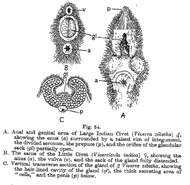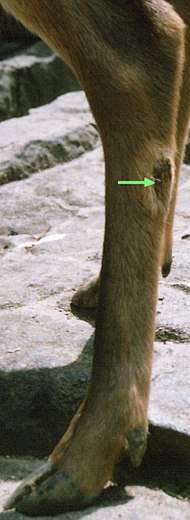Scent gland
| Scent gland | |
|---|---|
 | |
 The arrow is pointing to the metatarsal gland of a Sika deer | |
| Details | |
| Identifiers | |
| Latin | glandula odorifera |
| Anatomical terminology | |
Scent glands are exocrine glands found in most mammals. They produce semi-viscous secretions which contain pheromones and other semiochemical compounds. These odor-messengers indicate information such as status, territorial marking, mood, and sexual power. The odor may be subliminal—not consciously detectable.[1][2] Though it is not their primary function, the salivary glands may also function as scent glands in some animals.
In even-toed ungulates
The even-toed ungulates (Artiodactyla) have many specialized skin glands, the secretions of which are involved in semiochemical communication.[2] These glands include the sudoriferous glands (located on the forehead, between the antlers and eyes), the preorbital glands (extending from the medial canthus of each eye), the nasal glands (located inside the nostrils), the interdigital glands (located between the toes), the preputial gland (located inside the foreskin of the penis), the metatarsal glands (located outside of the hind legs), and the tarsal glands (located inside of the hind legs).[3]
Like many other species of Artiodactyla, deer have seven major external scent glands distributed throughout their bodies.[3] Deer rely heavily on these scent glands to communicate with other members of their species, and possibly even with members of other species. For example, male white-tailed deer (Odocoileus virginianus) are often seen working over a scrape. First, the animal scrapes at the dirt with its hooves, depositing the scent from his interdigital gland on the ground. After that, he may bite the tip off an overhanging branch, depositing secretions from his salivary glands onto the branch. He may then rub his face on the overhanging branch, depositing secretions from the sudoriferous and preorbital glands on it.[4]
The tarsal gland appears to operate by a different mechanism than the other external scent glands. A behavior called rub-urination is central to this mechanism. During rub-urination, the animal squats while urinating so that urine will run down the insides of its legs and onto its tarsal glands. The tarsal glands have a tuft of hair which is specially adapted to extract certain chemical compounds from the animal's urine. For example, in the black-tailed deer (Odocoileus hemionus columbianus), the major constituent of the tarsal gland secretion is a lipid, (Z)-6-dodecen-4-olide. This compound does not originate in the tarsal gland itself, but rather it is extracted from the animal’s urine by the tarsal hair tuft during the rub-urination process. In white-tailed deer, the presence and concentration of certain chemical compounds in the urine depend on the season, gender, reproductive status and social rank of the animals. This fact, along with the observation of rub-urination behavior in this animal (at least in the male) indicates that urine probably plays a role in olfactory communication in deer.[2]
In carnivorans
The fossa has several scent glands. Like herpestids it has a perianal skin gland inside an anal sac which surrounds the anus like a pocket. The pocket opens to the exterior with a horizontal slit below the tail. Other glands are located near the penis or vagina, with the penile glands emitting a strong odor. Like the herpestids, it has no prescrotal glands.[5]
In other animals
- Apocrine sweat glands, such as in the armpits of humans
- Sebaceous glands, such as the cranial surface glands of the red-bellied lemur
- Flank glands, such as in voles or shrews[6]
- Anal glands, found in all carnivora including bears,[7] sea otters[8] and kinkajous[9]
- Castor sacs, found in beavers
- Perineal glands, found in viverrids,[10] guinea pigs,[11] and porcupines[12]
See also
- Deer musk
- Red fox#Scent glands
- White-tailed deer#Marking
- Ozadenes, defensive glands of some arthropods that emit noxious compounds
References
- ↑ Albone, ES (1984). "Scent glands". Mammalian semiochemistry: the investigation of chemical signals between mammals. New York: John Wiley and Sons. pp. 74–134. ISBN 978-0471102533.
- 1 2 3 Burger, BV (2005). "Mammalian semiochemicals". In Schulz, S. The chemistry of pheromones and other semiochemicals II (PDF). Topics in current chemistry. 240. Berlin: Springer-Verlag. pp. 231–78. doi:10.1007/b98318. ISBN 3-540-21308-2. ISSN 0340-1022.
- 1 2 Nickens, TE (2009-11-05). "Understanding seven deer glands". Field & Stream Online. New York: Field & Stream. Retrieved 2012-05-27.
- ↑ "Understanding deer glands". Huntley, Illinois: Hunting Network, LLC. 2012. Retrieved 2012-05-21.
- ↑ Köhncke, M.; Leonhardt, K. (1986). "Cryptoprocta ferox" (PDF). Mammalian Species (254): 1–5. doi:10.2307/3503919. Retrieved 19 May 2010.
- ↑ Wolf and Johnson; Johnson, Martha F. (1979). "Scent Marking in Taiga Voles (Microtus xanthognathus)". Journal of Mammalogy. 60 (2): 400–04. doi:10.2307/1379814. ISSN 0022-2372. JSTOR 1379814.
- ↑ Dyce, KM; Sack, WO; Wensing, CJG (1987). Textbook of Veterinary Anatomy. W.B. Saunders Company. ISBN 0-7216-1332-2.
- ↑ Kenyon, KW (1969). The Sea Otter in the Eastern Pacific Ocean. Washington, D.C.: U.S. Bureau of Sport Fisheries and Wildlife.
- ↑ Ford, LS; Hoffman, RS (1988). "Potos flavus". Mammalian Species. 321: 1–9. doi:10.2307/3504086. JSTOR 3504086.
- ↑ R. F. Ewer (1973). The Carnivores. Cornell University Press. ISBN 0-8014-8493-6.
- ↑ Beauchamp, Gary K. "The perineal scent gland and social dominance in the male guinea pig." Physiology & behavior 13.5 (1974): 669-673.
- ↑ Roze, U., et al. "Microanatomy and bacterial flora of the perineal glands of the North American porcupine." Canadian Journal of Zoology 88.1 (2009): 59-68.